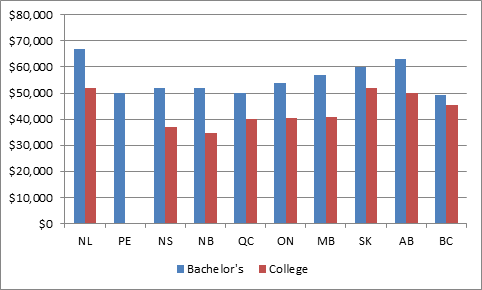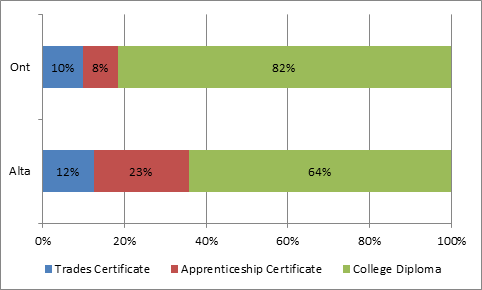So, you may remember that last week I published this neat little graph from the National Graduates Survey, showing university and graduate incomes across all ten provinces, three years after graduation. Note that although the numbers vary by province, the university number is always higher than the college number.
Median Earnings of College and Bachelor’s Graduates Three Years After Graduation, in 2013
The super-keen among you may also remember something I wrote three weeks ago, about a paper by Kelly Foley and David Green, which I summarized thusly:
“In Ontario and Quebec, returns to education are what you’d expect: higher for graduate degrees than for Bachelors, which in turn are higher than for college diplomas. But it turns out that both in the Atlantic and in the West, the returns to college education are actually higher than the returns to university. Indeed, in western Canada they are even higher than they are for graduate studies.”
How can both be true ? Basically, it’s because they’re using slightly different definitions of university and college.
Here’s the issue: Foley and Green used the Labour Force Survey data. That’s quite a different source of data from NGS. For instance, it includes graduates of foreign universities, who tend to make less than those educated locally. There’s not many of these in the 25-29 category, but it does reduce the university number a bit.
But the major reason is this: Foley and Green included “trades certificates and apprenticeships” in their definition of college. At one level that’s fair enough, because most (though not all) of the technical training that occurs in apprenticeships occurs in colleges. But on the other hand, it does obscure some important differences between the two.
Start with income. Ten years ago, males 25-29 holding trade certificates and college diplomas made almost the same amount; now, there’s an enormous gap.
Median Weekly Wages, Males Aged 25-29
Now, look at the distribution by region of Foley/Green’s “college” population. In Ontario, less than 20% of this population holds a trade or apprenticeship credential; in Alberta it’s over 35%.
Distribution of College/Trade Credentials Among Males 25-29, Ontario and Alberta (Source: National Household Survey)
So, to summarize: Within the Foley/Green description of college graduates there are two distinct groups, one of whom makes more than the other. And the better-off group is more prevalent in the west than it is in Central Canada. So it’s not that young Western Canadian male college diploma holders are better off than young Western Canadian male university bachelor’s graduates, it’s that young Western Canadian males who received training in colleges are better off than young Western Canadian male university bachelor’s graduates.
I hope that’s clear.
This college/trade advantage disappears relatively quickly after age 30, but I’ll get to that another time.




 Tweet this post
Tweet this post
